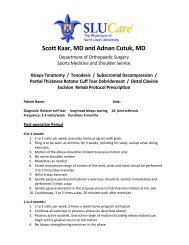The effects of third-order torque and self - Saint Louis University
The effects of third-order torque and self - Saint Louis University
The effects of third-order torque and self - Saint Louis University
You also want an ePaper? Increase the reach of your titles
YUMPU automatically turns print PDFs into web optimized ePapers that Google loves.
with elastomeric ligatures). Friction values obtained from<br />
both passive <strong>self</strong>-ligating sets at ±5 degrees remained<br />
significantly smaller than the friction produced by the<br />
Victory set, likely due to the absence <strong>of</strong> any other than<br />
incidental contact from ligation within these <strong>self</strong>-ligating<br />
bracket-slots.<br />
With the exception <strong>of</strong> the In-Ovation R set <strong>and</strong><br />
positive angles, increasing the <strong>torque</strong> from ± 5 to ±10<br />
degrees brought the frictional resistances from the <strong>self</strong>-<br />
ligating attachment-sets to magnitudes similar to those<br />
from the Victory sets. This finding contrasted outcomes<br />
from a previous study 44 that found <strong>self</strong>-ligating brackets to<br />
produce smaller frictional forces than traditionally<br />
ligated brackets with <strong>torque</strong> placed. In the present<br />
research, interaction <strong>of</strong> the wire with the slot walls, as<br />
well as with the ligating mechanism, would be expected to<br />
occur when approaching ±10 degrees <strong>of</strong> <strong>torque</strong>, possibly<br />
tempering the alleged advantage <strong>of</strong> smaller frictional<br />
resistance that is commonly associated with <strong>self</strong>-ligating<br />
brackets. <strong>The</strong> marked increase in friction found in the<br />
<strong>self</strong>-ligating (but not in the Victory) sets when increasing<br />
the <strong>torque</strong> from ±5 degrees to ±10 degrees suggest that<br />
there were faciolingual force additions from substantial<br />
contacts with the ligating mechanisms. <strong>The</strong> In-Ovation R<br />
68
















